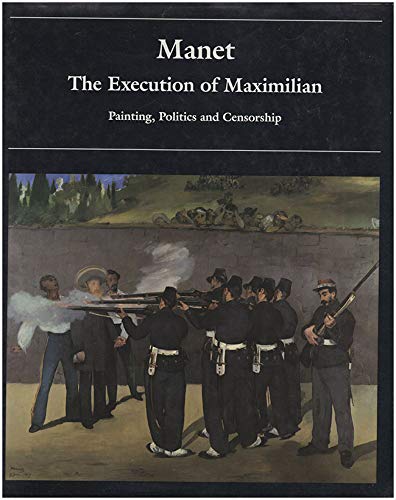
Synopsis
The execution by firing squad in 1867 of Maximilian, the puppet emperor installed in Mexico by Napoleon III, was to have far-reaching implications, shattering the international prestige of France and hastening the collapse of the Second Empire. For Edouard Manet, already known in Paris as a non-conformist painter, this tragic event led to a surge of anti-imperial sentiment in his work, causing him to be labeled politically dangerous as well as artistically subversive. In this richly illustrated book, Juliet Wilson-Bareau reveals in Manet's paintings a political side little known to general admirers of impressionist art. Not only does she discuss the circumstances in which Manet painted his three large versions of The Execution of Maximilian, often seen as an isolated outburst of political feeling, but she also shows that many of his most familiar works from the 1860s take issue with contemporary events. Drawing from eyewitness accounts and newspaper reports, Wilson-Bareau examines possible sources for the paintings and the development of Manet's imagery. Douglas Johnson's historical account of the French intervention in Mexico, and John House's discussion of Salon painting in the 1860s, place Manet's choice of subject and style in a broad context of political and artistic opposition to Napoleon III. Inspired by an exhibition at the National Gallery in London, this book presents Manet's paintings alongside related drawings, sketches, prints, and photographs.
"synopsis" may belong to another edition of this title.
Reviews
"The Execution of Maximilian" was painted by Edouard Manet in three successive versions from 1867 to 1869. This catalog for a show at London's National Gallery, which is exhibiting all versions, presents three essays exploring the milieu in which the paintings were made. The first essay covers the event that rocked Paris and embarrassed Napoleon III, who had installed and later abandoned the ill-fated Mexican emperor. The middle essay suggests Manet's interest in politics as information filtered back to Europe past the censors, showing artifacts such as a photograph of the emperor's bullet-torn shirt and portrait of the soldiers who shot him. It also compares Goya's famous "Third of May 1808" to the image Manet finally painted. The final essay considers heroic military painting, popular at the time, which Manet despised. The visuals are excellent. But the essays, taken as a whole, leave ambiguous the artist's true intentions and seem addressed to an audience of scholars who can best appreciate its factual, dry tone. For comprehensive collections.
- Ellen Bates, New York
Copyright 1992 Reed Business Information, Inc.
"About this title" may belong to another edition of this title.
Other Popular Editions of the Same Title
Search results for Manet: The Execution of Maximilian: Painting, Politics,...
Manet: The Execution of Maximilian - Painting, Politics, and Censorship
Seller: Ultramarine Books, Brooklyn, NY, U.S.A.
Hardcover. Condition: Fine. Dust Jacket Condition: Fine. First Edition. London: National Gallery Publications, 1992. 138 pages; 115 illustrations, color and b&w; Provenance and Exhibition History of the Maximilian Paintings; Chronology 1821-84 (global historic events); Bibliography. An exhibition of Manet's three Maximilian Paintings, the first time since his death and an examination of the political import of the paintings and of the execution, itself. First Edition. Cloth. Fine/Fine. 4to. Language: ENG. Seller Inventory # 002219
Manet: The Execution of Maximilian Painting, Politics and Censorship
Seller: Foster Books - Stephen Foster - ABA, ILAB, & PBFA, London, United Kingdom
Hardcover. Condition: Very Good. Dust Jacket Condition: Very Good. 128 pp., published to accompany the exhibition at the National Gallery in London in 1992. 0691032092 4to. Seller Inventory # 57566
Buy Used
Quantity: 1 available
Manet: The Execution of Maximilian: Painting, Politics, and Censorship
Seller: Toscana Books, AUSTIN, TX, U.S.A.
Hardcover. Condition: new. Excellent Condition.Excels in customer satisfaction, prompt replies, and quality checks. Seller Inventory # Scanned0691032092
Manet: The Execution of Maximilian: Painting, Politics, and Censorship
Seller: A Cappella Books, Inc., Atlanta, GA, U.S.A.
Oversized Hardcover. Condition: Good. Dust Jacket Condition: Good. Seller Inventory # 273729
Manet: The Execution of Maximilian: Painting, Politics, and Censorship
Seller: BennettBooksLtd, San Diego, NV, U.S.A.
Hardcover. Condition: New. In shrink wrap. Looks like an interesting title! Seller Inventory # Q-0691032092
Manet: The Execution of Maximilian: Painting, Politics, and Censorship
Seller: Les Livres des Limbes, Chisseaux, France
Hardcover. Condition: Near Fine. Dust Jacket Condition: Very Good. Shadow marks in black background of dust jacket due to mild scuffing. In every other respect like new condition. Illustrations, 132 pages, 23 x 27,8 cm. 132 p. Book. Seller Inventory # 017307

